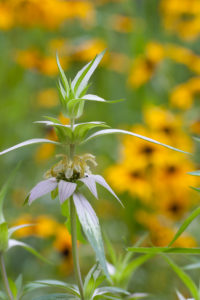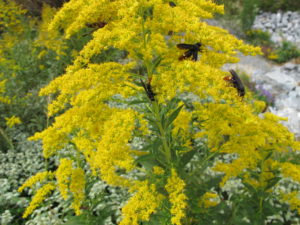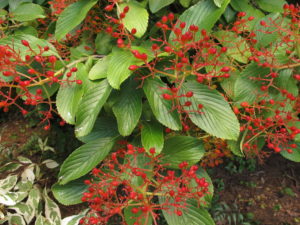A Naturalistic Approach to Landscaping
Posted on Tuesday, March 10, 2020 · Leave a Comment
I recently attended a lecture and slide show by Dan Jaffe, horticulturalist at Norcross Wildlife Sanctuary in Wales, Massachusetts. Dan Jaffe is a talented and passionate gardener who single handedly maintains 75 acres of woodland, meadow and bog garden.

Monarda punctuata Photo by Dan Jaffe
Although building self-sustaining gardens on 75 acres sounds like a lot for one man to do, he does this by working with nature instead of trying to mold nature to fit his will. I’d like to share some of his ideas, as they make sense to me.
Dan Jaffe started by listing problems to avoid. First, he said, avoid over-spacing what you plant. If a plant tag suggests planting 24 inches apart, divide that by two or three (8 to 12 inches apart) to get a mature look in less time. Avoid bark mulch as much as possible – use spreading ground covers like running foam flower or woodland phlox that will fill in quickly but not over-run other plants.
Pruning plants to limit size and thin out excess growth is good, but pruning shrubs into “meatballs and rocket ships” is bad. Limit lawn in a landscape. Don’t think of all insects as pests: your native plants, in particular, are important food for the larvae of pollinators (which are, in turn, good food for baby birds). Don’t rake up the leaf litter in fall – it is home to many beneficial insects. Let short-lived perennials (like columbine) set and drop seeds so they can replenish themselves.
A key feature of a successful naturalistic garden is choosing the right plant for the right place. Start by getting a soil test done before you begin. And look at what is growing at your site before you choose plants – they can tell you much, if you pay attention to them.
If the soil is poor, choose plants that do well in low-nutrient soils. It is difficult to make a sun-loving plant that needs plenty of moisture thrive if you plant it in dry, sandy soil. After the first season you should not have to water or fertilize your plants if you have selected them well.
So, for example, if you want bee balm and have dry, sandy soil, choose spotted bee balm – Monarda punctata- instead of Monarda didyma, the most commonly sold variety. Yes, the latter is sold everywhere, but it needs rich, moist soil. It’s true that the common variety comes in several nice colors and the spotted bee balm does not, but if you want a low-maintenance garden, pick the right plant for the place.

Native pollinators love goldenrod
Learn that any given genus (a scientific grouping of biologically similar plants) has numerous species. Goldenrod (genus Solidago) has 53 species that grow in New England. Granted, some get very tall and spread by root quite aggressively. But there are other species that are clumping, not running in habit and all support pollinators very well. According to Dan Jaffe, goldenrods support 115 species of pollinators in our area.
Wreath goldenrod (Solidago caesia) is a delicate-looking species that I grow and love. It grows in shade or part shade and blossoms in the fall. I bought mine at The Garden in the Woods, a non-profit garden in Framingham, Massachusetts that sells many species of native plants.

Another plant that Dan Jaffe likes is one that I like, too, goldenstar (
Chrysogonum virginianum). It will grow in sun or shade and does well anywhere except soggy soils. Two great aspects of the plant are that it spreads politely and re-blooms often. The best blossoms are in spring. It spreads by rhizome, and can serve as a good groundcover with bright yellow star-shaped blossoms an inch or so across. The foliage is handsome, and low-growing. Dan stated that it is easy to make cuttings that will grow if a node is buried directly in the soil. Technically a Zone 5 plant, I have grown it in cold Zone 4 locations.
Shrubs are good in a natural garden, too. One that Dan Jaffe likes is fragrant sumac (Rhus aromatica). A related species, staghorn sumac (Rhus typina) is well known as a roadside plant 10 to 15 feet tall that spreads vigorously by root and can be a pest. But this one is shorter and better behaved. Although its blossoms are not showy, the fall foliage is excellent and the leaves are fragrant. It will grow in 3 to 6 feet tall and spreads, so it can be used as a groundcover.

Most Viburnums are nice shrubs that offer flowers and berries.
Another shrub for tough dry and shady locations is mapleleaf viburnum (Viburnum acerifolium). Apparently it has fabulous fall color, from reds to deep purple. It is only 4 to 5 feet tall at maturity. It has nice white flowers in the spring and shiny black fruit in the fall. It is very tolerant to cold, good to Zone 3.
Dan Jaffe did not tell us all to get rid of our lawns. He understands that lawns are nice for kids to play on, and are soothing to look at. But a big lawn is not the best way to support birds or pollinators. Native plants are.
Dan Jaffe and Mark Richardson wrote a wonderful book in 2018 called
Native Plants for New England (Globe Pequot Press) which I highly recommend. It includes nice photographs and good growing information on trees, shrubs and wildflowers you might want to consider for your landscape. His website is
www.dantjaffe.com.
Henry is the author of 4 gardening books. He is available to speak to your garden club or other group. His e-mail is
henry.homeyer@comcast.net.
 Another plant that Dan Jaffe likes is one that I like, too, goldenstar (Chrysogonum virginianum). It will grow in sun or shade and does well anywhere except soggy soils. Two great aspects of the plant are that it spreads politely and re-blooms often. The best blossoms are in spring. It spreads by rhizome, and can serve as a good groundcover with bright yellow star-shaped blossoms an inch or so across. The foliage is handsome, and low-growing. Dan stated that it is easy to make cuttings that will grow if a node is buried directly in the soil. Technically a Zone 5 plant, I have grown it in cold Zone 4 locations.
Another plant that Dan Jaffe likes is one that I like, too, goldenstar (Chrysogonum virginianum). It will grow in sun or shade and does well anywhere except soggy soils. Two great aspects of the plant are that it spreads politely and re-blooms often. The best blossoms are in spring. It spreads by rhizome, and can serve as a good groundcover with bright yellow star-shaped blossoms an inch or so across. The foliage is handsome, and low-growing. Dan stated that it is easy to make cuttings that will grow if a node is buried directly in the soil. Technically a Zone 5 plant, I have grown it in cold Zone 4 locations.




